How to learn to see the brain. Review of the book "Visual Thinking" by Dan Roem
They say that in life it is enough to read one book ... but in order to find it, you will have to reread several hundred others. “Visual thinking: how to“ sell ”your ideas with the help of visual images” is exactly that single book. It will be interesting and useful to anyone who is interested in visualization, art, perception, features of their own thinking. Despite the word “sell” in the title, the book is much wider than the description of business processes or sales techniques, and this makes it universal. She will answer dozens of complex (theoretical) questions, teach (in practice) to look, see, imagine and show. One can understand a lot from the book, read and reread, study illustrations (good, simple illustrations) and find something amazing every time.
I will list 5 of my finds
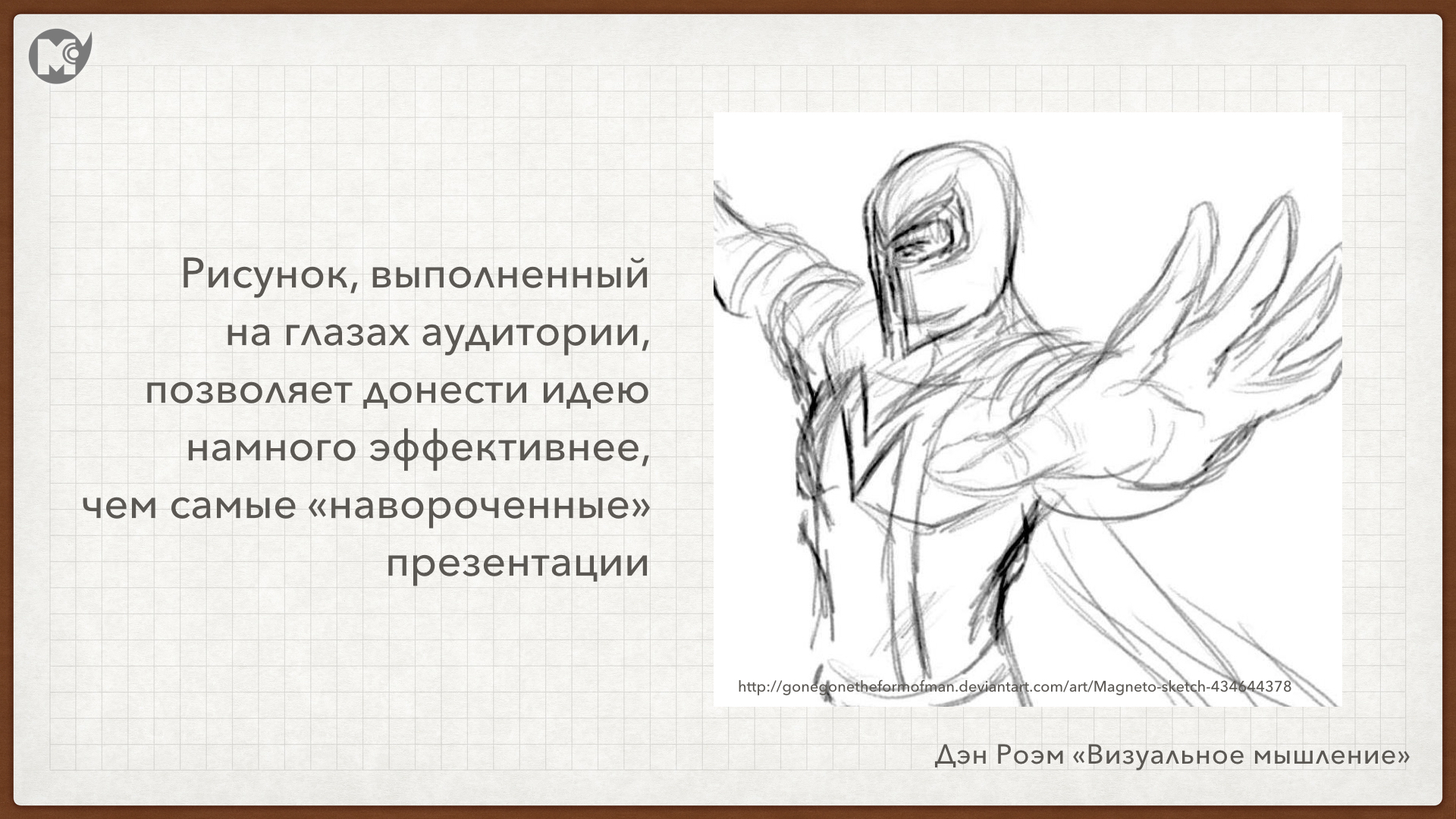
')
The main task of the author is to teach how to solve problems using visual thinking. More precisely, not to teach, but to recall the natural natural ability to see a picture, to imagine, develop images and draw conclusions on this basis.
To solve this problem, Dan Roem offers to go through all the stages of visual thinking :
These stages were the first find in the book. It struck me how simple everything is and how this mechanism works in practice (by the way, the author is 100% oriented towards practice and does not give any “outside” information).

These stages underlie the composition of the book :
Part one "Solving problems by visualizing them": an introduction to the essence of the issue, the mechanism of visual thinking. The second part is “Rules and tools of visual thinking” (see, see stages); the third is “The practice of applying visual thinking in business” (imaginary stage) and the fourth one is “Popularization of ideas” (demonstration stage). The appendix, “The Scientific Foundations of Visual Thinking”, turned out to be no less interesting than the content of the book itself.
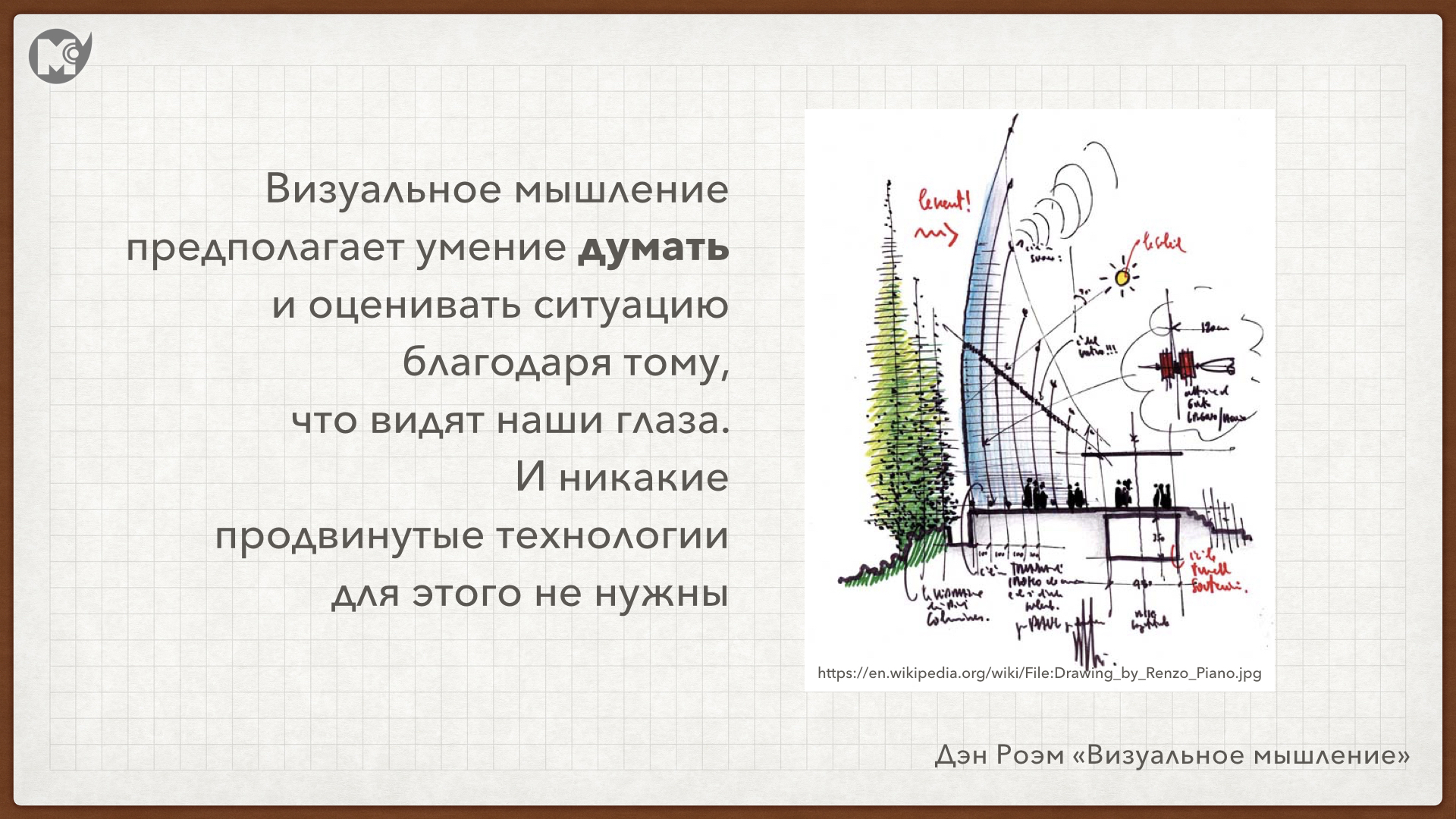
My second discovery was the idea that "the success of visual thinking does not depend on artistic talent or education . " Many colleagues (teachers) do not use in their work a powerful tool for visualizing information, fearing that they cannot draw. And so I find a remedy against these fears (and the author proves it several times throughout the book): “visual thinking is first and foremost an ability to think . ” The main thing is to gather information, focus, develop the idea, after which the stage of the show will be simple and natural.
Dan Roem - holder of advanced degrees in the field of art and biology - leads the reader to the path that our brain follows, perceiving visual images.
First we look at the data, at the maximum amount of information collected. Then, we begin to select the necessary objects, "to peer".
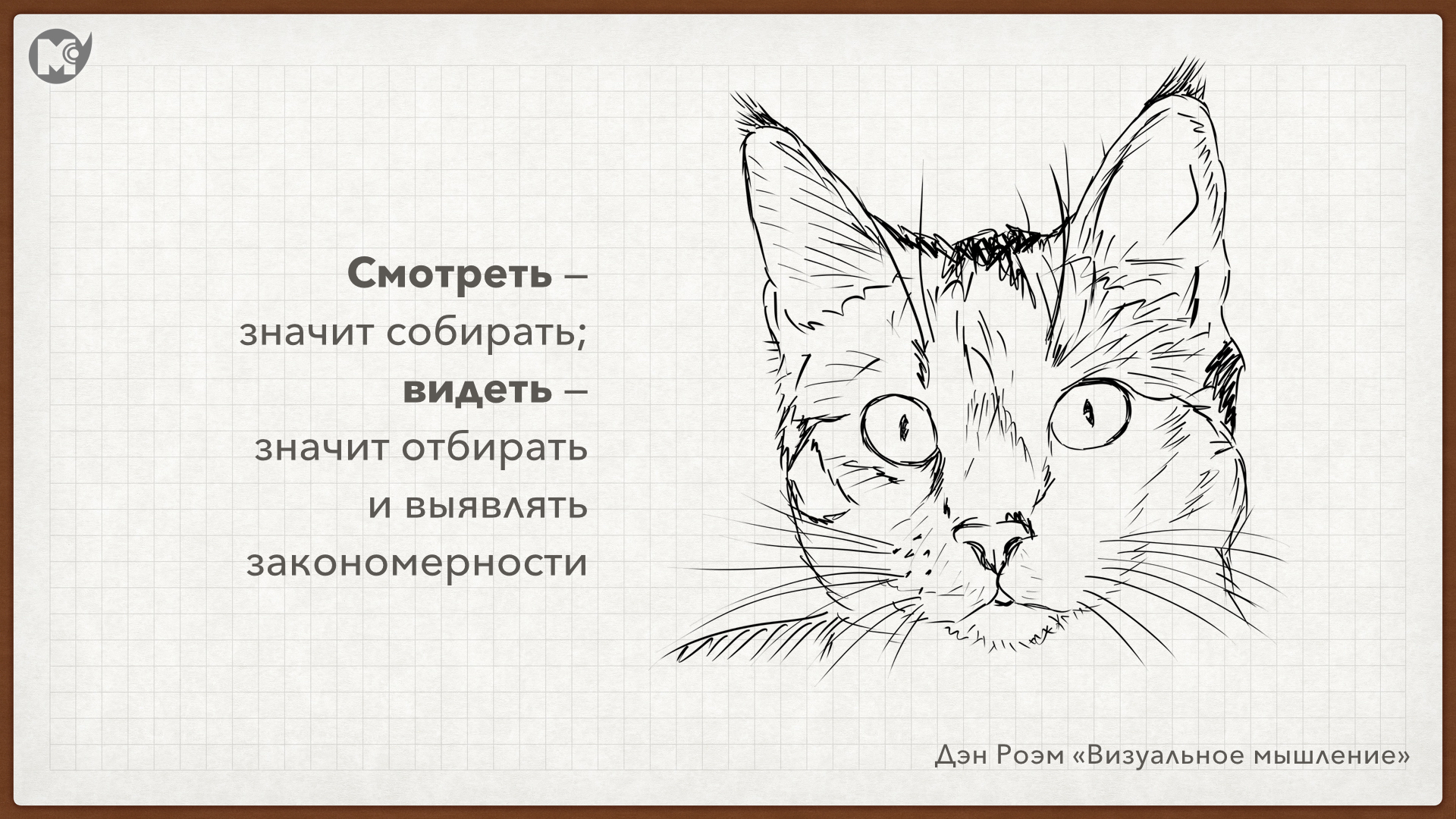
At this stage (find number 3) we learn that all problems (their visual embodiment) can be described by answering six questions. All that we see around is 6 categories: who / what, how much, where, when, how and why . People are naturally in this framework, our eyes and the brain analyze everything in the world, fitting into the framework of time and space. The mechanism is obvious if you watch the children, but over time is forgotten by adults. But it always works.
The speed of vision and visual processing of information is explained by the “pre-cognitive processing of information” (the brain already sees and processes it, but we are not aware of this yet). After seeing an object, the brain determines who or what it is (living, dangerous, edible, moving, etc.), then how much of it (many or one), where it is (far, close, vertically, horizontally), when (what something happens to the object or to us), how it works and why it happens (or not, the cause).
The author argues that at the stage of "looking" you need to answer one main question.
of these 6. On this will depend on the success of the development of the image and its display - that is, explaining the idea to other people.
Thus, the visual reproduction of the situation helps to understand the causes of what is happening.

After we focused the vision (and the brain) on a particular object, we chose a question that interests us the most (for example, asking the question "who?", Analyzing all the information about the significant qualities of the object, to make it as clear as possible "portrait") . The more information gathered, the clearer and more accurate we will be able to answer the question you need, “pulling” all relevant facts and data.
The advantage of images over words in the speed of their processing, in that the brain is more accustomed to the figurative form of information processing. So we can change the combination of objects, sequence, relationships with other objects and immediately "see" the answer to the question of interest to us.

The collected (depicted) data and their focused consideration start the process of imagination (the third stage of visual thinking). This is the moment of discovery, the "eureka." It is possible to see (predict) what is not immediately visible: causes, patterns, relationships, trends, deviating data, outstanding objects or qualities, etc.
Transmitting the “pure” ideas of the author, I did not note that the author illustrates these ideas with examples from life, describes situations and problems (mostly from business) that could be solved with the help of drawings.
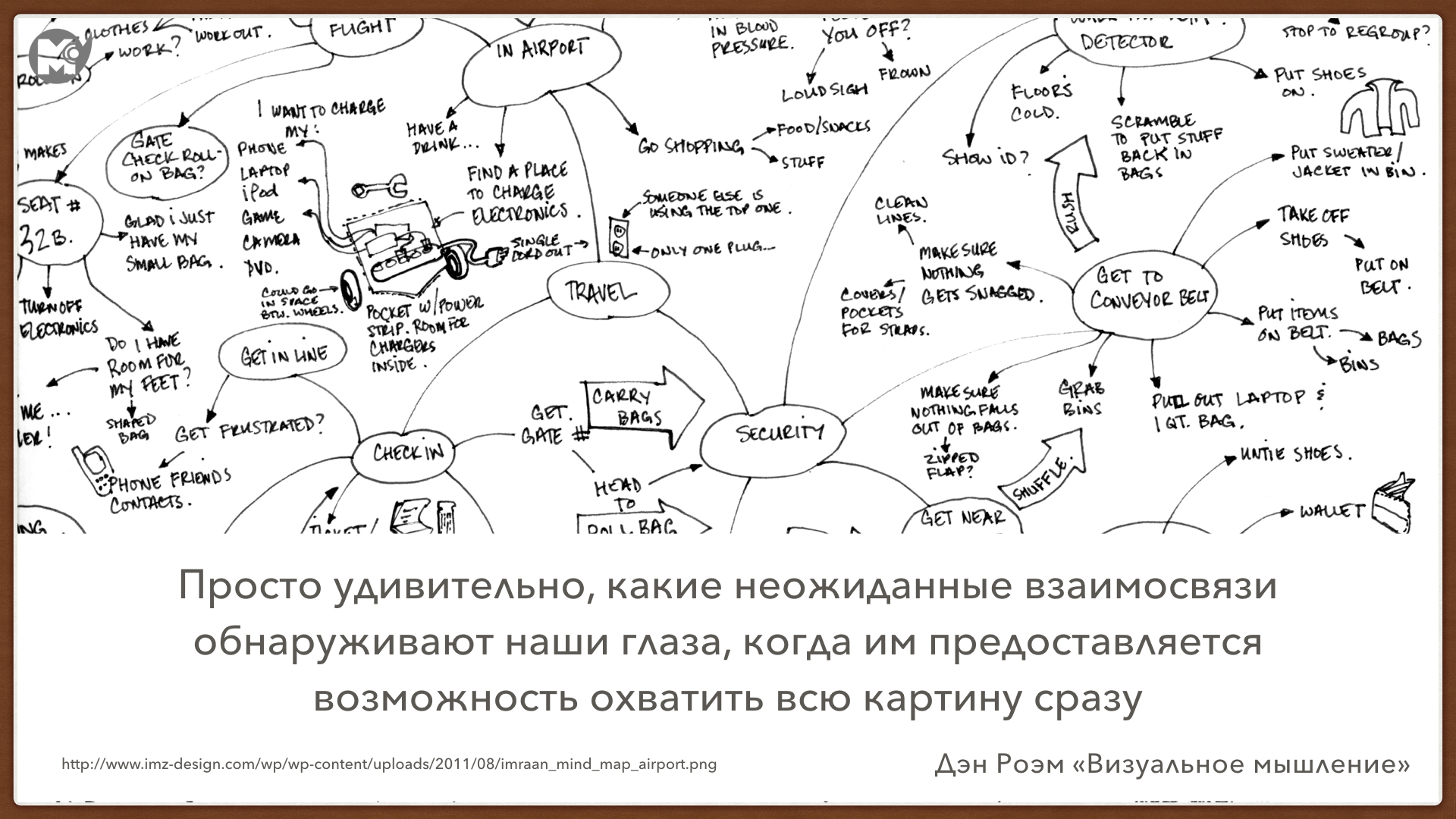
Having seen what was hidden in the flow of information, we can show it to others. And to prove, using a visual language that is understandable and close to everyone from birth. Moreover, "the success of the visual thinking of the problem does not depend on artistic talent or education." The main thing - reliance on the six issues listed above. The fourth finding is the correspondence of the types of drawings to the answers to these questions - a portrait, a block diagram, a map, a time line, a diagram and a graph with variable parameters . We can express all variety of problems with the help of 6 types of drawings!

To effectively show your idea, people just need to focus on answering one of these questions (on a question that is interesting to the audience) and use the appropriate type of picture (infographic). This will be the perfect match between the information and the form of its expression. Show ideas in a natural, natural, fast and understandable way for other people.

The original title of the book " The Back of the Napkin: Solving Problems and Selling Ideas with Pictures " - "The reverse side of the napkin: solving problems and selling ideas through drawings." The author talks about drawing his ideas in any place and at any time, for example, on the back of a napkin when meeting with business partners in a cafe. Proves that anyone can draw, because all the images consist of simple, basic elements - a circle, a square, a line (arrow), a triangle.
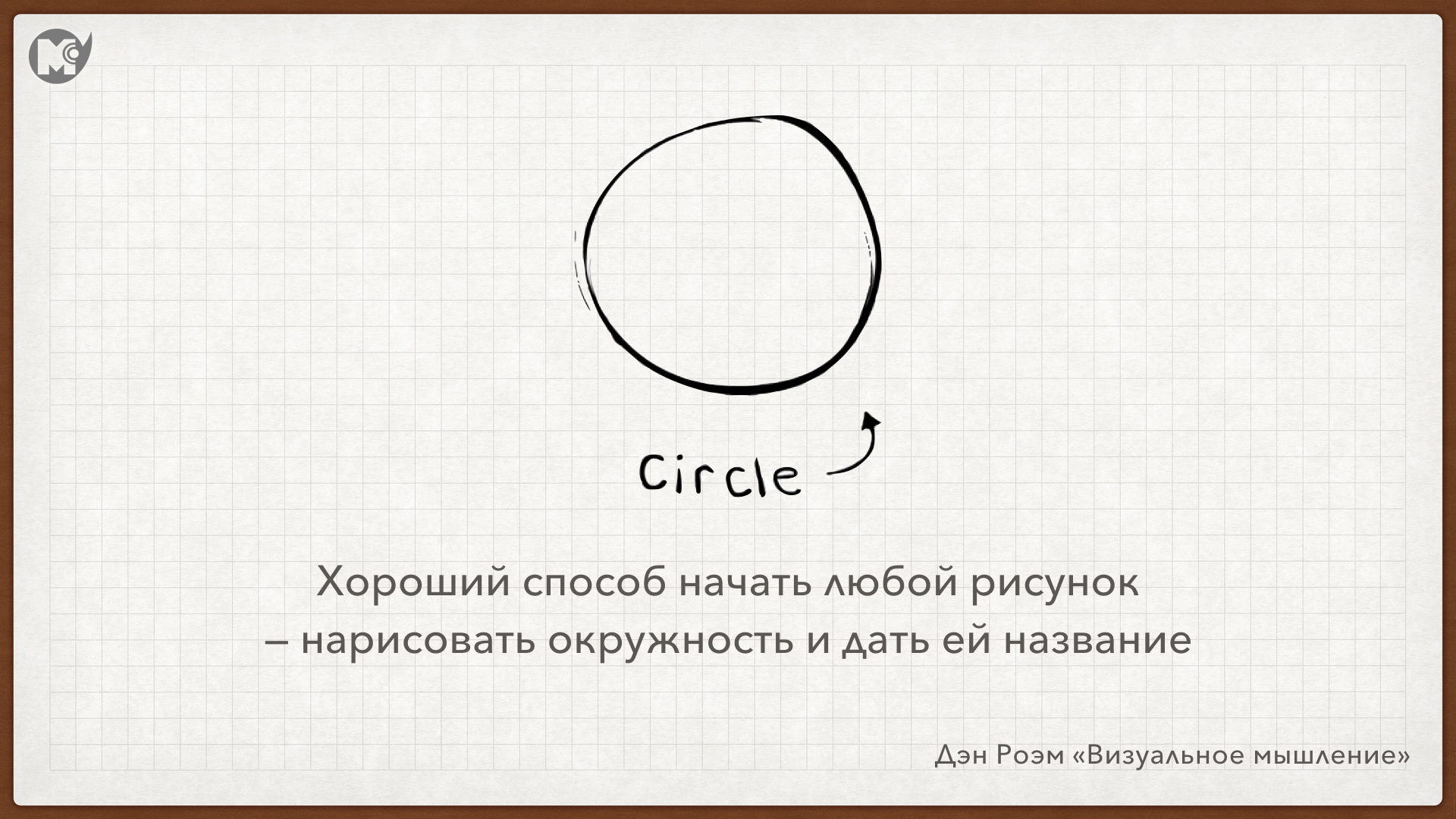
Despite the fact that the book is about drawing, the method of working with images is more than universal. It is implemented in a diagram, infographic, training or advertising video, presentation of ideas, etc. The fifth find for me was the process of displaying the drawing, demonstration . Make a beautiful visual image is not enough. You need to demonstrate it correctly. And the completion of visualization - the show - again corresponds to the stages of visual thinking, which is spoken to the audience in the way the author of the visual idea passed - where he looked, what he saw, what he imagined and what it all means (how or why it works).
Sources of information (authoritativeness, sufficient amount) are described, boundaries, coordinate axes, object evaluation criteria are specified, then the viewer's attention is focused on the subject of analysis (deviations from average values, outstanding qualities of the subject) and on what it says, how it helps to solve the problem . A simple display of the most high-quality, developed image can give nothing. It is necessary to "look out loud."

There are many other great ideas in the book Visual Thinking. For example, three types of visual viewers:
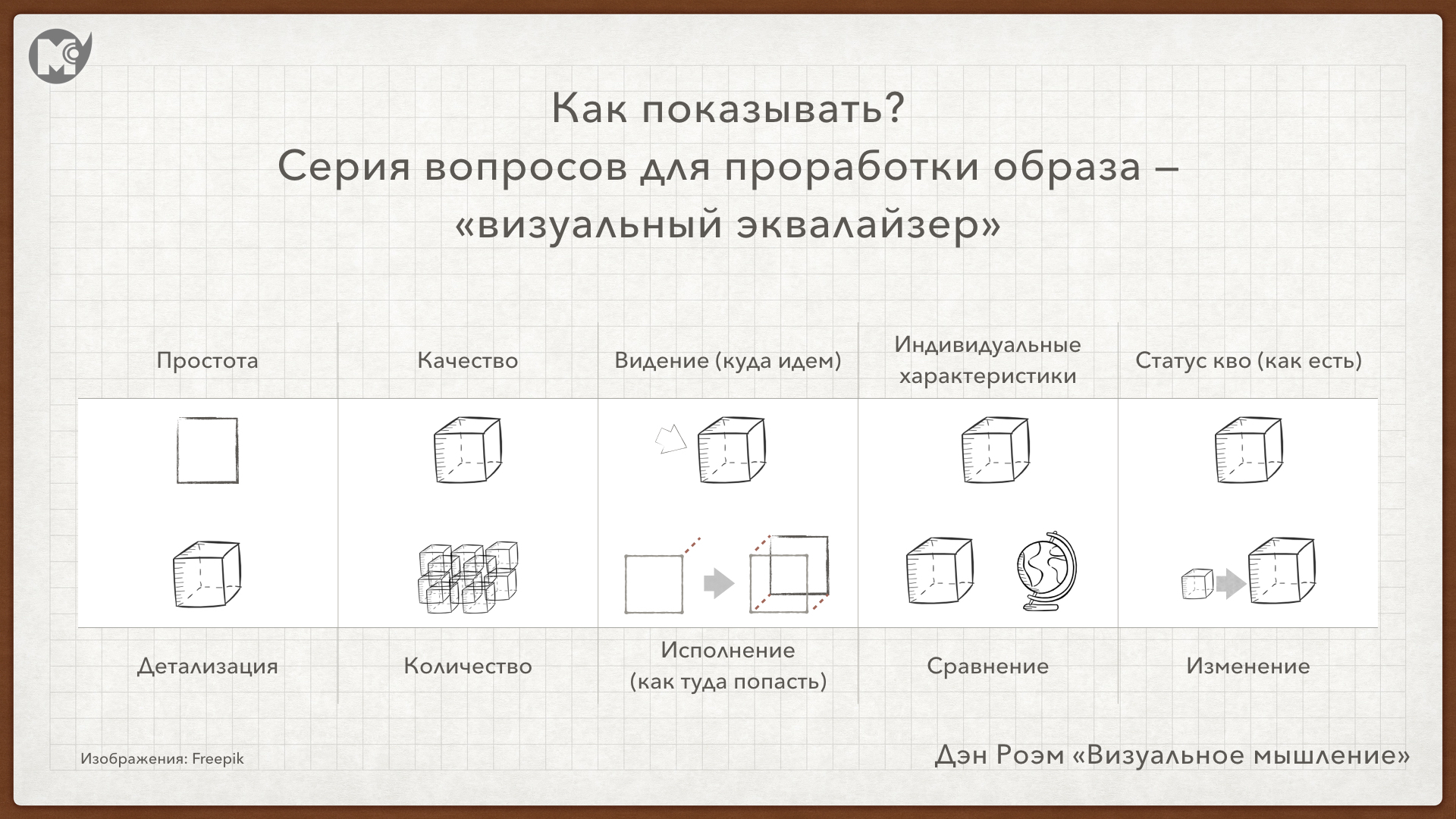
A series of questions for the study of the image - "visual equalizer" (simplicity or detail, quality or quantity, vision or performance, comparison or individual characteristics, status quo or change).
And much more, about which there is no point in telling, this can be understood only with the independent reading of the book. I just threw five glittering gold coins one after another to show the way to the real treasure chest. The main thing for me to discover in this book turned out to be consonant with the ideas of other legendary visual thinkers (artists, researchers): the key to everything is the ability to look and see, contemplation.
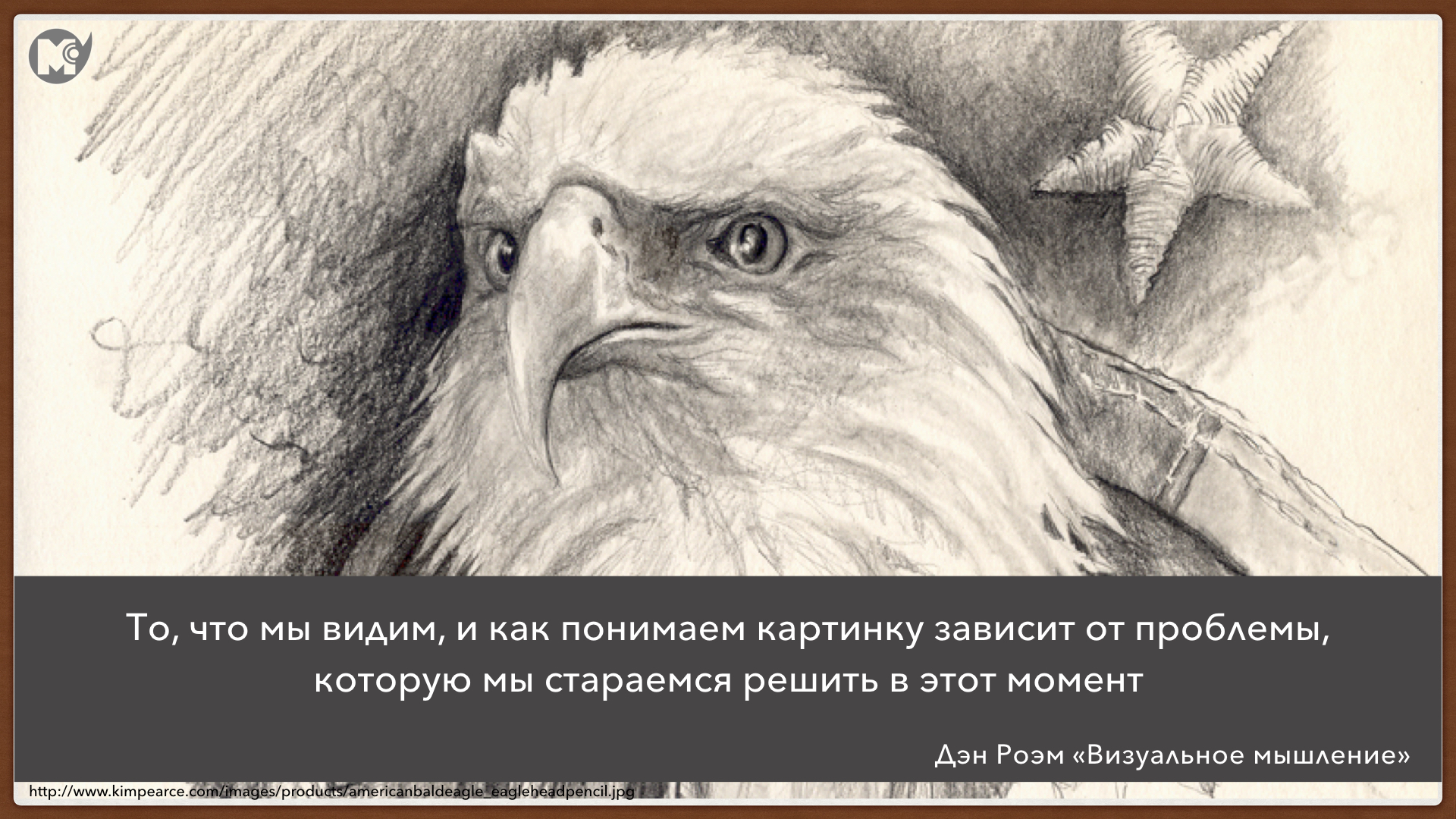
I will list 5 of my finds

')
The main task of the author is to teach how to solve problems using visual thinking. More precisely, not to teach, but to recall the natural natural ability to see a picture, to imagine, develop images and draw conclusions on this basis.
To solve this problem, Dan Roem offers to go through all the stages of visual thinking :
- finding an idea (how to improve the ability to look and see)
- development of an idea (how to see specific images used to solve a problem in all visual information),
- popularization (how to show your pictures to other people).
These stages were the first find in the book. It struck me how simple everything is and how this mechanism works in practice (by the way, the author is 100% oriented towards practice and does not give any “outside” information).

These stages underlie the composition of the book :
Part one "Solving problems by visualizing them": an introduction to the essence of the issue, the mechanism of visual thinking. The second part is “Rules and tools of visual thinking” (see, see stages); the third is “The practice of applying visual thinking in business” (imaginary stage) and the fourth one is “Popularization of ideas” (demonstration stage). The appendix, “The Scientific Foundations of Visual Thinking”, turned out to be no less interesting than the content of the book itself.

My second discovery was the idea that "the success of visual thinking does not depend on artistic talent or education . " Many colleagues (teachers) do not use in their work a powerful tool for visualizing information, fearing that they cannot draw. And so I find a remedy against these fears (and the author proves it several times throughout the book): “visual thinking is first and foremost an ability to think . ” The main thing is to gather information, focus, develop the idea, after which the stage of the show will be simple and natural.
Dan Roem - holder of advanced degrees in the field of art and biology - leads the reader to the path that our brain follows, perceiving visual images.
First we look at the data, at the maximum amount of information collected. Then, we begin to select the necessary objects, "to peer".

At this stage (find number 3) we learn that all problems (their visual embodiment) can be described by answering six questions. All that we see around is 6 categories: who / what, how much, where, when, how and why . People are naturally in this framework, our eyes and the brain analyze everything in the world, fitting into the framework of time and space. The mechanism is obvious if you watch the children, but over time is forgotten by adults. But it always works.
The speed of vision and visual processing of information is explained by the “pre-cognitive processing of information” (the brain already sees and processes it, but we are not aware of this yet). After seeing an object, the brain determines who or what it is (living, dangerous, edible, moving, etc.), then how much of it (many or one), where it is (far, close, vertically, horizontally), when (what something happens to the object or to us), how it works and why it happens (or not, the cause).
The author argues that at the stage of "looking" you need to answer one main question.
of these 6. On this will depend on the success of the development of the image and its display - that is, explaining the idea to other people.
Thus, the visual reproduction of the situation helps to understand the causes of what is happening.

After we focused the vision (and the brain) on a particular object, we chose a question that interests us the most (for example, asking the question "who?", Analyzing all the information about the significant qualities of the object, to make it as clear as possible "portrait") . The more information gathered, the clearer and more accurate we will be able to answer the question you need, “pulling” all relevant facts and data.
The advantage of images over words in the speed of their processing, in that the brain is more accustomed to the figurative form of information processing. So we can change the combination of objects, sequence, relationships with other objects and immediately "see" the answer to the question of interest to us.

The collected (depicted) data and their focused consideration start the process of imagination (the third stage of visual thinking). This is the moment of discovery, the "eureka." It is possible to see (predict) what is not immediately visible: causes, patterns, relationships, trends, deviating data, outstanding objects or qualities, etc.
Transmitting the “pure” ideas of the author, I did not note that the author illustrates these ideas with examples from life, describes situations and problems (mostly from business) that could be solved with the help of drawings.

Having seen what was hidden in the flow of information, we can show it to others. And to prove, using a visual language that is understandable and close to everyone from birth. Moreover, "the success of the visual thinking of the problem does not depend on artistic talent or education." The main thing - reliance on the six issues listed above. The fourth finding is the correspondence of the types of drawings to the answers to these questions - a portrait, a block diagram, a map, a time line, a diagram and a graph with variable parameters . We can express all variety of problems with the help of 6 types of drawings!

To effectively show your idea, people just need to focus on answering one of these questions (on a question that is interesting to the audience) and use the appropriate type of picture (infographic). This will be the perfect match between the information and the form of its expression. Show ideas in a natural, natural, fast and understandable way for other people.

The original title of the book " The Back of the Napkin: Solving Problems and Selling Ideas with Pictures " - "The reverse side of the napkin: solving problems and selling ideas through drawings." The author talks about drawing his ideas in any place and at any time, for example, on the back of a napkin when meeting with business partners in a cafe. Proves that anyone can draw, because all the images consist of simple, basic elements - a circle, a square, a line (arrow), a triangle.

Despite the fact that the book is about drawing, the method of working with images is more than universal. It is implemented in a diagram, infographic, training or advertising video, presentation of ideas, etc. The fifth find for me was the process of displaying the drawing, demonstration . Make a beautiful visual image is not enough. You need to demonstrate it correctly. And the completion of visualization - the show - again corresponds to the stages of visual thinking, which is spoken to the audience in the way the author of the visual idea passed - where he looked, what he saw, what he imagined and what it all means (how or why it works).
Sources of information (authoritativeness, sufficient amount) are described, boundaries, coordinate axes, object evaluation criteria are specified, then the viewer's attention is focused on the subject of analysis (deviations from average values, outstanding qualities of the subject) and on what it says, how it helps to solve the problem . A simple display of the most high-quality, developed image can give nothing. It is necessary to "look out loud."

There are many other great ideas in the book Visual Thinking. For example, three types of visual viewers:
- "Black pen" (1/4 of the entire audience, draw from scratch, like visual metaphors),
- “Yellow pen” (1/2 of the audience complement and highlight something in the picture, underline, note interesting aspects, comment)
- “Red pen” (1/4 of the audience, criticize, redraw, love facts and figures).

A series of questions for the study of the image - "visual equalizer" (simplicity or detail, quality or quantity, vision or performance, comparison or individual characteristics, status quo or change).
And much more, about which there is no point in telling, this can be understood only with the independent reading of the book. I just threw five glittering gold coins one after another to show the way to the real treasure chest. The main thing for me to discover in this book turned out to be consonant with the ideas of other legendary visual thinkers (artists, researchers): the key to everything is the ability to look and see, contemplation.

Source: https://habr.com/ru/post/327498/
All Articles